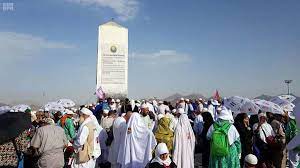MOUNT ARAFAT: On Friday, the culmination of the largest hajj pilgrimage since the pandemic forced drastic reductions in numbers two years in a row, massive crowds of Muslim pilgrims prayed on Saudi Arabia’s Mount Arafat.
On the rocky rise where the Prophet Mohammed (PBUH) delivered his final sermon, congregations of worshippers read passages from the Quran while many of them protected themselves from the harsh sun with umbrellas.

The highlight of the pilgrimage, prayers on Mount Arafat, also known as the “Mount of Mercy,” are limited to one million people this year, including 850,000 from abroad after Covid significantly reduced numbers over 2020 and 2021.
Many of the pilgrims travelled to Mount Arafat on foot or in buses from the nearby tents where they spent the night, chanting “Oh God, here I am” as they did so.
They will travel to Muzdalifah after dusk and spend the night there under the stars before performing the symbolic “stoning of the devil” ritual on Saturday.
“Like everyone else, I’m overjoyed to be here. Although this is the largest hajj in the coronavirus era, it is not yet large enough.” 49-year-old Egyptian traveller Saad Farhat Khalil
“There are one million here today, but ten million would have come if the Saudis had allowed more,” he continued.
As helicopters buzzed overhead and volunteers distributed water bottles and collected trash in green plastic bags, the entry roads were jam-packed with worshipers.
A sign on a big garbage can said, “Let’s keep the purest of all lands clean.”
One of the five pillars of Islam and typically one of the largest annual religious gatherings in the world, the hajj is something that every Muslim with the means must do at least once in their lifetime.
Similar to previous years, approximately 2.5 million Muslims from around the world participated in 2019, though that number fell to a few thousand in 2020 and 60,000 in 2021.
The hajj is taking place against the backdrop of a resurgence in the area, with some Gulf countries tightening restrictions to keep outbreaks in check, even though the crowds are back. Covid fears also persist, despite the resurgence.
Proof of complete immunisation and negative PCR tests were prerequisites for participation. On Thursday, they were given tiny bags containing masks and hand sanitizer when they arrived at their white-tent camp at Mina.
Even in ideal circumstances, the pilgrimage can be physically taxing, but this year’s worshippers faced an additional obstacle: a scorching sun and temperatures that reached 42 degrees Celsius (108 degrees Fahrenheit).
Islam forbids men from donning hats once the rituals begin, so many have been observed using umbrellas, prayer mats, and in one instance, even a small bucket of water to provide protection.
Women must wear scarves to cover their heads, however.
“We can put up with (the heat). We’re here to perform the hajj. The more we put up with, the more people will accept our pilgrimage “a 64-year-old Iraqi pilgrim named Laila who only gave her first name
The hundreds of hospital beds set aside for heatstroke patients and the “large number of misting fans” that have been provided are among the measures Saudi officials have praised as part of their preparations for the extreme weather.
Additionally, a truck has been designated to deliver small fans, water bottles, and umbrellas.
“We can put up with (the heat). We’re here to perform the hajj. The more we put up with, the more people will accept our pilgrimage “a 64-year-old Iraqi pilgrim named Laila who only gave her first name
The hundreds of hospital beds set aside for heatstroke patients and the “large number of misting fans” that have been provided are among the measures Saudi officials have praised as part of their preparations for the extreme weather.
Additionally, a truck has been designated to deliver small fans, water bottles, and umbrellas.



